
“There has been a significant uptick in sweet potato consumption in the last several years," says Jamie Earp. "More people are concerned about eating healthier —sweet potatoes are extremely nutritious — and the popularity of sweet potato fries in restaurants has given an added boost to demand."

Sometimes there are life-changing moments, and for Jamie Earp one of those occurred in 1995.
Although he’d grown up working on the family farm, and continued to help out while going to school, he says farming wasn’t on his career agenda. “You couldn’t have told me in those days that I’d end up farming — it was the farthest thing from my mind.”
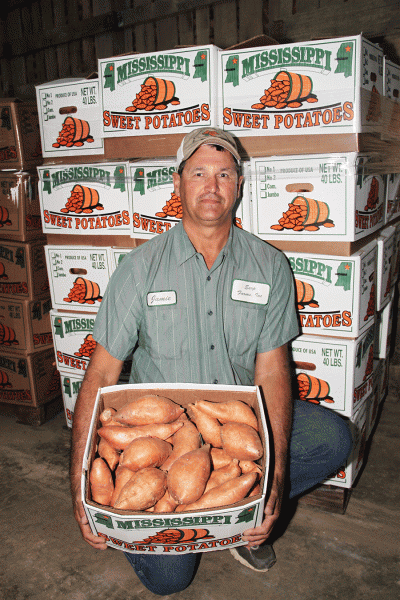
“We sell our sweet potatoes year-round to a warehouse in Birmingham, Ala., and we also sell through brokers, who call us when they need a shipment,†says Jamie Earp, who is president of the Mississippi Sweet Potato Council and in 2014 served as president of the U.S. Sweet Potato Council.
After school, he worked in the area furniture industry that had spread across much of north Mississippi, but continued to help his father, Howard, in the sweet potato operation he’d started in 1968 with 80 acres near the town of Houlka in Chickasaw County.
“One day in ’95,” says Earp (it’s pronounced Arp, as in Sharp), “I was out here working on the farm, and something just clicked: I knew this was what I wanted to do. I quit my job and started working with Daddy. I helped him run things until 1997, when my brother, Ricky, and I bought the sweet potato operation and the land our parents owned.
Stay current on what’s happening in Mid-South agriculture: Subscribe to Delta Farm Press Daily.
“There were a few rough spots early on, but I’ve never for a minute regretted my decision. We’ve got a good, solid business that produces between 4 million and 4.5 million pounds of sweet potatoes each year. It’s work I enjoy doing, and I’m happy things have turned out the way they have.”
Earp, who is completing the last year of a two-year term as president of the Mississippi Sweet Potato Council and served in 2014 as president of the U.S. Sweet Potato Council, says the Mississippi industry, centered in the counties surrounding the town of Vardaman, is experiencing solid growth.
“There has been a significant uptick in consumption in the last several years because more people are concerned about eating healthier —sweet potatoes are extremely nutritious. The popularity of sweet potato fries in restaurants has also created a boost in demand that has helped to utilize the smaller potatoes that seven or eight years ago would have just been left in the field because there was no market for them. ConAgra has a plant in Louisiana that buys a lot of processing grade potatoes for fries.”
Acreage in the state last year was 19,500, Earp says. “This year it’s around 22,000, almost all of it in this north Mississippi area. In the past, acreage has been as high as 24,000. There are probably 80 to 90 growers in this area; seven or eight of them have 1,000 acres or better, but most are in the 250 to 400 acre range.”
Mississippi No. 2 in sweet potato production
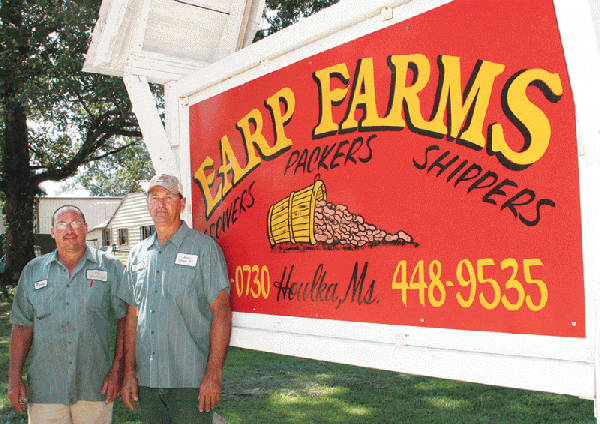
Earp Farms was started by Ricky and Jamie Earp’s late father, Howard, in 1968, with 80 acres. The brothers have gradually acquired more land, and now have 1,800 acres of crop and timber acreage.
North Carolina is the No. 1 sweet potato-producing state, Mississippi is second, and California is third. “Since May this year,” Earp says, “prices have been higher than for the past couple of years, running $16 to $18 for a 40-pound carton. Within the last three years, the price has been as low as $12.50 per carton. During the holiday period, the price will usually drop about $1 per carton. About 30-35 percent of our sales are at Thanksgiving, 10 percent at Christmas, and 15 percent at Easter, with the remainder spread out over the year.”
As was the case with most Mississippi farmers who were plagued by rain delays this spring, the Earps got off to a late start with planting. “We usually start about May 20,” he says, “but it was too wet and we didn’t actually begin until June 6. We finished June 22, with 250 acres total, which is about what we have year-in, year-out.
“It takes 90 days from planting for the crop to mature, and we like to start digging around Sept. 1. We don’t like to go into late September or October, because the weather can start to get uncertain. We’ll cut vines off the tops of the potatoes five or six days before digging; this allows the skins to toughen.
“We planted three varieties this year: Beauregard, which is pretty much the standard in Mississippi; Evangeline, which is sweeter, but not as consistent in yield as Beauregard; and Orleans, which was released three years ago and is growing in popularity. All are varieties developed in Louisiana. About 60 percent of our acreage is Beauregard, 30 percent Orleans, and 10 percent Evangeline.”
Important upcoming events: Delta Farm Press Calendar of Events
Each year, Earp says, about 30 percent to 40 percent of their plantings will be from first generation foundation seed potatoes that are certified virus-free. The rest are seed potatoes — about ¾ inch to 1 inch in size — they save during fall harvest to use in growing their own transplants for the following year’s crop. “Second generation is as far as we go with our own saved seed potatoes,” he says, “in order to limit the potential for viruses to start coming in.”
In spring, when the ground temperature is 65 to 75 degrees, they bed up the seed potatoes in dirt and cover them with plastic. After shoots start appearing, the plastic is removed and the beds are covered with Agribond, a felt material that holds moisture.
Spring planting a labor-intensive process
“When the plants get 8-10 inches tall,” Earp explains, “we cut them off and let them sit out for a couple of nights to toughen and begin to put out feeder roots. Then we roll the planting beds, spray with Valor, and begin placing transplants into the field.”
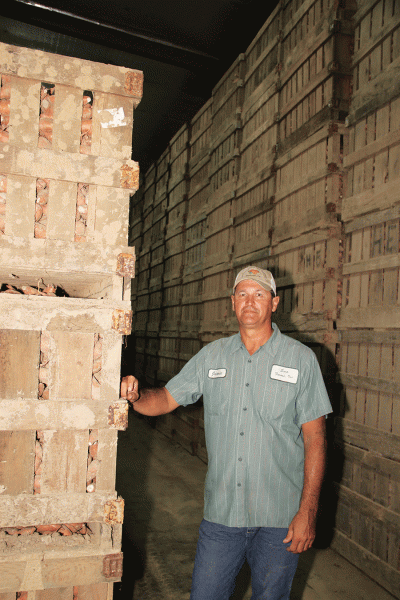
When weather gets warm, sweet potatoes are stored at 60 degrees and cleaned and packed as orders come in. “We aim to have all our old crop stock sold and shipped by the time the new crop is harvested,†says Jamie Earp.
Workers riding the planting machine place the transplants into the soil by hand. Ideal planting depth is 4 inches to 6 inches. About a week after going into the field, plants beginning putting out roots and in about 21 days potatoes will begin forming.
“After planting, we make an over-the-top application of Command and a half rate of Dual,” Earp says. “We follow that two weeks later with another half rate of Dual for control of nutsedge, which is one of our worst weeds. We also have to deal with cocklebur and pigweed. Thus far, we’ve had no resistant pigweed. If we get rain to activate the Valor, it pretty much takes care of the pigweed. We’ve got one of the cleanest crops this year that we’ve had in a long time.”
Insects aren’t usually a major problem, Earp says. North Mississippi is a “green tag” area, which means it is free of the destructive sweet potato weevil that is a problem in the state south of Interstate 20.
“We have a consultant who scouts weekly,” he says, “and we follow his recommendations. We sprayed once early season for cutworms, and every year we’ll have armyworms in August to some extent, but damage isn’t usually enough require spraying. About two years ago, we had to spray a field where armyworms were causing damage.”
Because good, loose soil is needed for potatoes to grow well and have the best shape, as well as for digging in the fall, they disk-till planting fields every year. They also soil test yearly and apply lime and fertilizer based on test recommendations.
“We’re doing some variable rate fertilization now,” Earp says, “and we’ll eventually expand that to all our acres. Variable rate has worked well with our lime applications, and we’ve seen cost savings compared to broadcast applications. We’ll average 40 to 50 units of nitrogen every year, and potash and other nutrients vary according to soil test.”
Sweet potato/soybean rotation helps control diseases
The Earps own 1,800 acres total; 800 of that is farmland and the rest is in pine and hardwoods. In addition to sweet potatoes, they grow about 50 acres of grain sorghum, and the rest of the cropland is rented to a soybean grower. Every three years, they rotate sweet potatoes to land that has been in soybeans, which helps to prevent disease buildup.
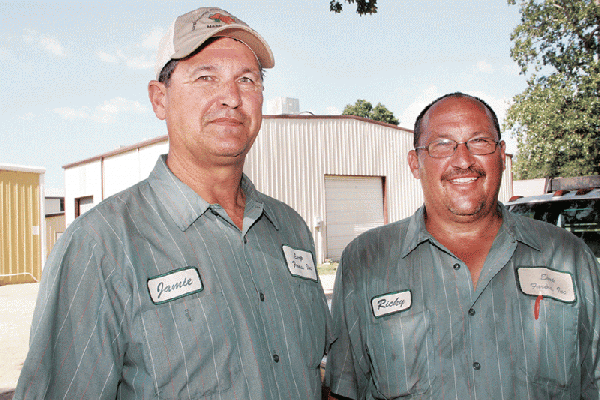
The Earp Brothers, Jamie, left, and Ricky, bought the family sweet potato operation from their parents in 1997.
When potatoes are mature, about five or six days before digging, a cutter tool is used to cut off the vines and allow the potato skins to toughen and reduce skinning.
When digging starts, machines go through the field and turn the potatoes up onto a conveyor belt, and workers riding on the machine sort the potatoes as they feed by on the belt. There are eight workers on the digger. The potatoes are field packed in wooden boxes according to grade, and trucked to the packing facility to be stored as they came from the field, dirt and all. Their father built a new packing shed and packing line in 2008, which Earp says made for a more efficient operation (their father died in 2009.)
“We want to hold the potatoes at a temperature of about 80 degrees, with 75 percent to 80 percent humidity, for about two weeks,” he says. “This sets the skins and starts the process of converting starches to sugars. Then we use fans to pull outside air through them to start cooling them. As orders come in, we’ll wash potatoes, inspect them, and box them for pickup. We like to have all old crop potatoes sold by the time the new crop is ready to ship.
Check current commodity prices
“Thanksgiving is our peak demand period,” Earp says, “which is why we like to start digging around the first of September — we need six weeks for natural curing to take place before we begin to pack and ship.”
“We sell year-round to a warehouse in Birmingham on an order basis, and we also sell through brokers, who call us when they need a shipment. We pack in boxes with their brand and they pick them up at our shed. We also do some local area sales.
2014 was 'our best year ever: 5 million pounds'
“The No. 1 size is where we make our best money; the more of those we have, the better. USDA specifications call for No. 1 to be 2 inches to 3 inches in diameter and 6 inches to 9 inches long. About 75 percent of our production will be No. 1, 10 percent No. 2, 10 percent jumbos, and 5 percent processing. We harvested 5 million pounds last year, our best year ever, thanks to some timely rains early in the season.
“The potatoes that are culled in the packing process we sell locally to people who want them for deer feed.” There’s some irony in that, he admits, since deer are a big problem for growers — “almost any night during growing season, I can see five or six deer in a field. Wild hogs are also getting to be a problem in a few places, but thus far we’ve not had any.”
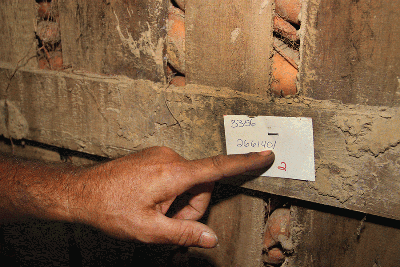
Each lot of sweet potatoes has identity information that goes with the product all the way to retail. “If there’s a problem, we can trace potatoes back to a particular field,†says Jamie Earp.
Around March 1, when weather starts getting hot, they move remaining potatoes into the cold storage shed, where they’re held at 60 degrees, to be cleaned and packed as orders come in.
“Our operation is USDA GAP (Good Agricultural Practices) and GHP (Good Handling Practices) certified,” Earp says. “This entails two full-blown inspections each year, one for which we’re given advance notice and one that’s unannounced. We also follow guidelines for record keeping, worker safety, pesticide applications, and other requirements. We keep records on each bin and should a question arise, we can trace the potatoes from the customer all the way back to the field of origin.”
Although they have land that could be used for expansion, Earp says their sweet potato operation is “pretty much where we want to be” in terms of size. It’s something Ricky and I can comfortably handle. We have a reliable local labor supply — people who for the most part have worked with us over the years. And my wife, Joy, and Ricky’s wife, Diana, help out, too.
“For planting, we’ll need 20-22 workers for about two and a half weeks and at harvest about 30 workers for about eight weeks. We have three harvester machines; each requires eight workers, and then there are those who run the tractors and forklifts and other operations. Some of those same people help out in packing and shipping throughout the year. In the area centered around Vardaman, there are probably 3,000 to 3,500 workers hired each fall during harvest; many are seasonal.”
When they have some free time, Earp says, he and Joy like to ride their shiny red Harley Screaming Eagle motorcycles. “For the past seven or eight years, we and four or five other couples have hauled our bikes out west to ride. Our last trip was through Montana and into Canada, covering 2,260 miles. We really enjoyed it.”
About the Author(s)
You May Also Like



